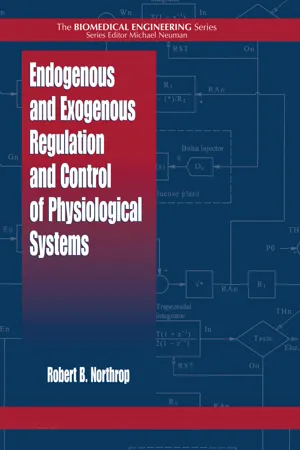
Endogenous and Exogenous Regulation and Control of Physiological Systems
- 464 pages
- English
- ePUB (mobile friendly)
- Available on iOS & Android
Endogenous and Exogenous Regulation and Control of Physiological Systems
About This Book
From a biomedical engineering perspective, this book takes an analytic, quantitative approach to describing the basic components of physiological regulators and control systems (PRCs). In Endogenous and Exogenous Regulation and Control of Physiological Systems, the author provides grounding in the classical methods of designing linear and nonlinear systems. He also offers state-of-the-art material on the potential of PRCs to treat immune system ailments, most notably AIDS and cancer. The book focuses on certain "wet" physiological regulators, such as those using endocrine hormones as parametric control substances. Endogenous and Exogenous Regulation and Control of Physiological Systems includes simulations that illustrate model validations and the putative control of cancer and HIV proliferation. It explores novel, untried immunotherapies on the cutting-edge of PRC treatment and explores the latest technologies.
Frequently asked questions
Information
1 Introduction to Physiological Regulators and Control Systems
1.0 INTRODUCTION
1.1 PHYSIOLOGY AND PHYSIOLOGICAL REGU...
Table of contents
- Cover
- Half Title
- Title Page
- Copyright Page
- Preface
- The Author
- Table of Contents
- Chapter 1 Introduction to Physiological Regulators and Control Systems
- Chapter 2 Physical and Chemical Factors Governing the Behavior of Physiological Regulators and Control Systems
- Chapter 3 Introduction to SISO Control Systems and Systems with Delays
- Chapter 4 Introduction to Compartmental Modeling and Pharmacokinetic Systems
- Chapter 5 Special Types of Closed-Loop Drug Input Controllers
- Chapter 6 Hormonal Regulation of Sodium, Potassium, Calcium, and Magnesium Ions
- Chapter 7 Regulation of Blood Glucose
- Chapter 8 Control of Mean Arterial Pressure by Sodium Nitroprusside Injection
- Chapter 9 Control of Postoperative Pain by Self-Administered Opioids
- Chapter 10 The Human Immune System Seen from a Biomedical Engineering Viewpoint
- Bibliography and References
- Appendix: Discussion of Simulation Languages for Physiological/Pharmacokinetic and Chemical Kinetic Systems
- Index